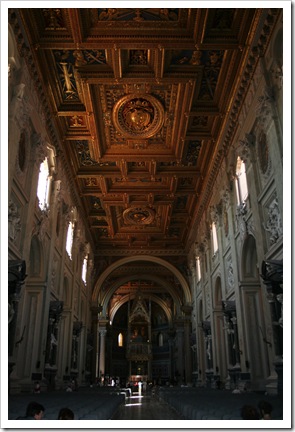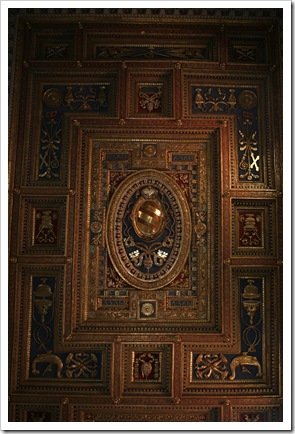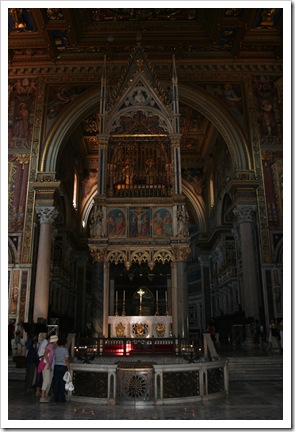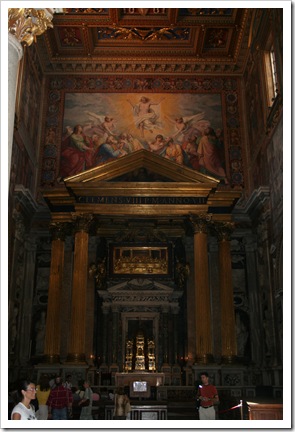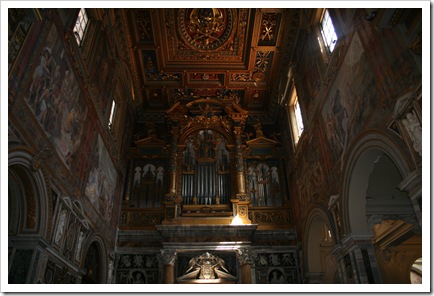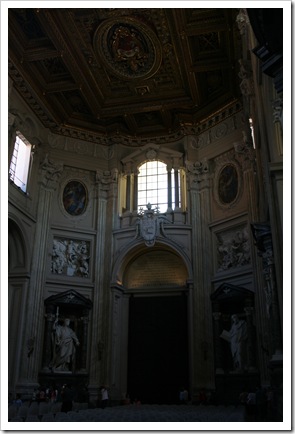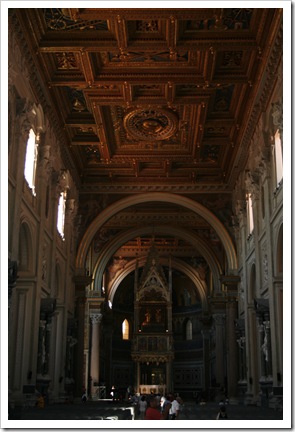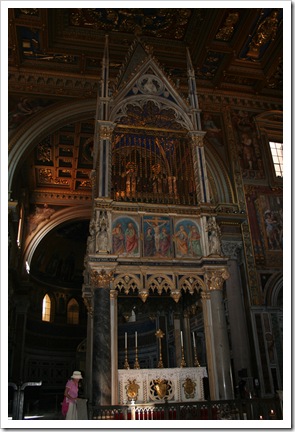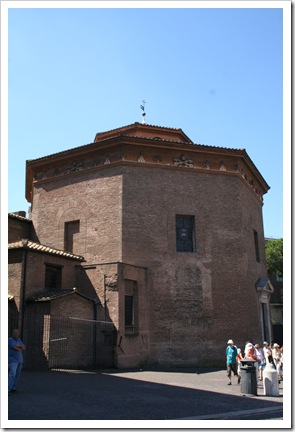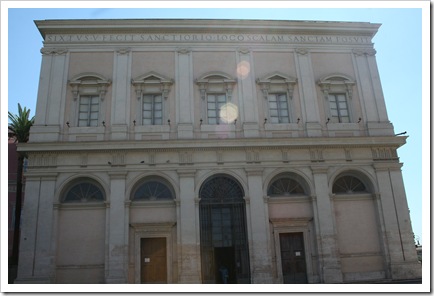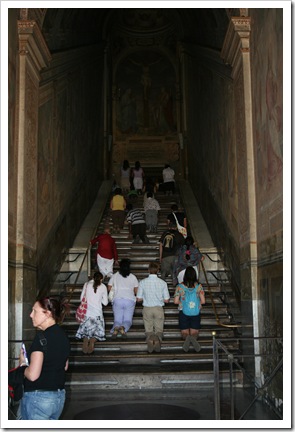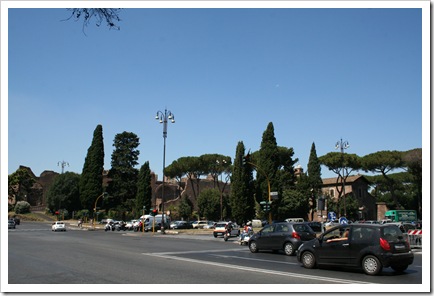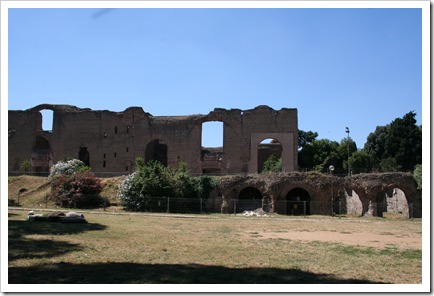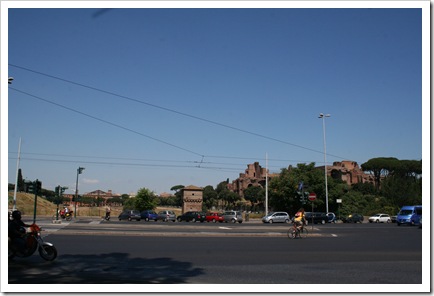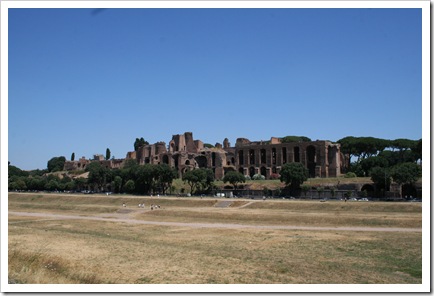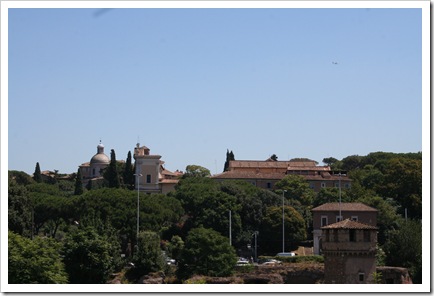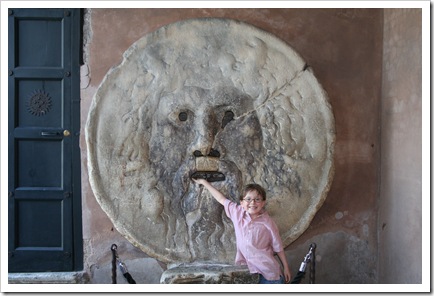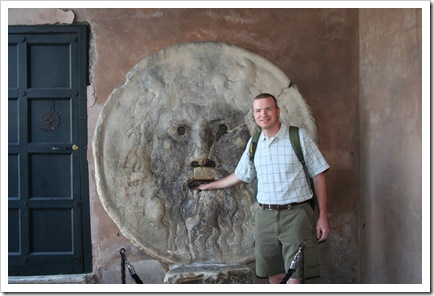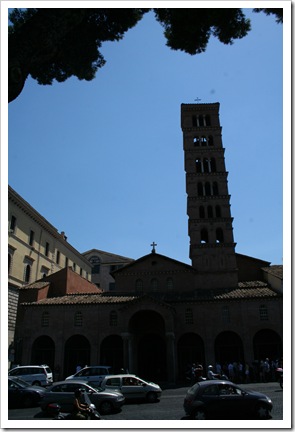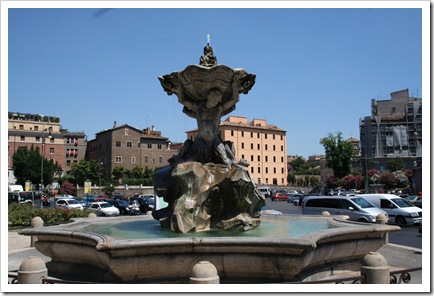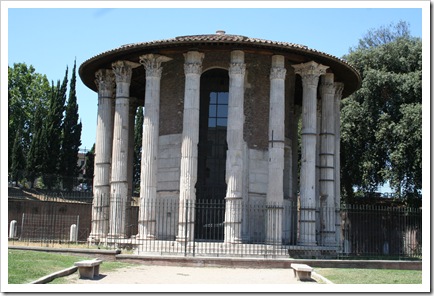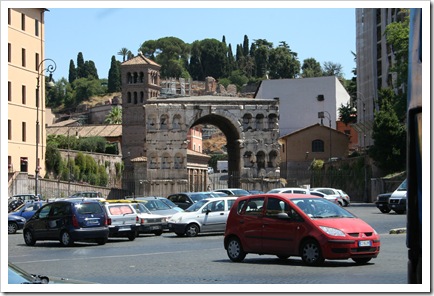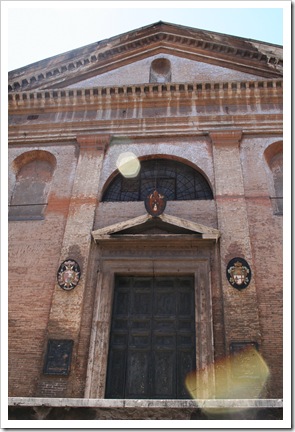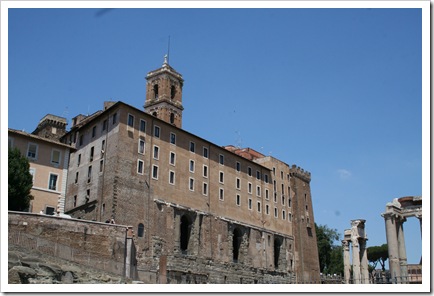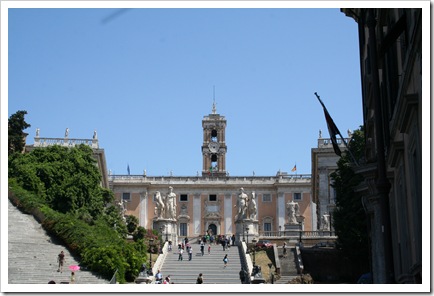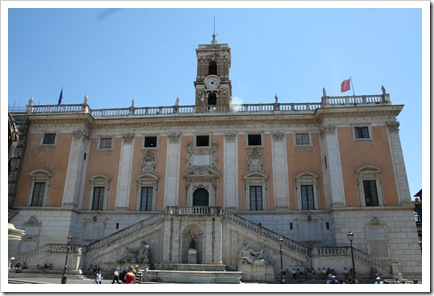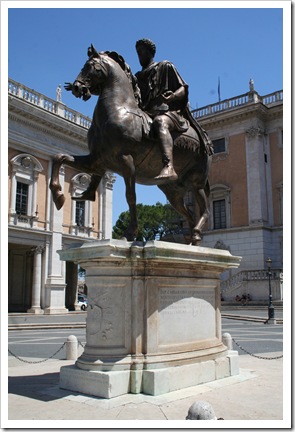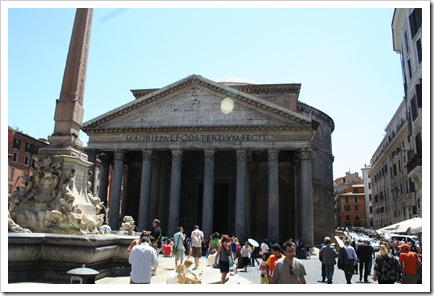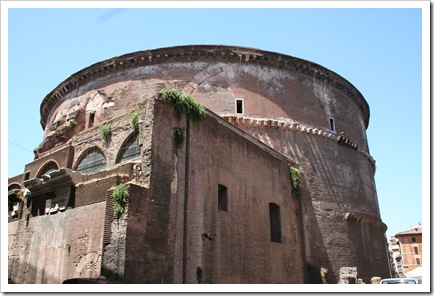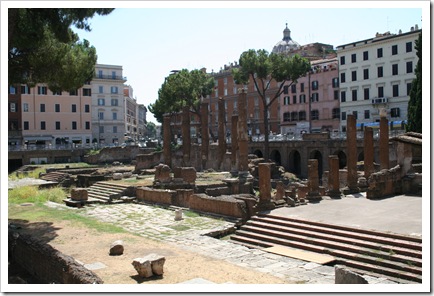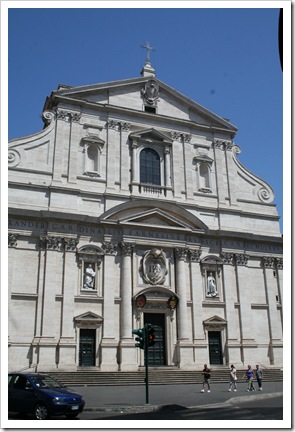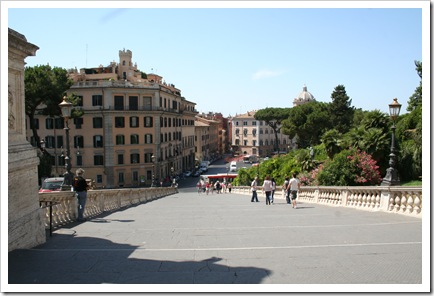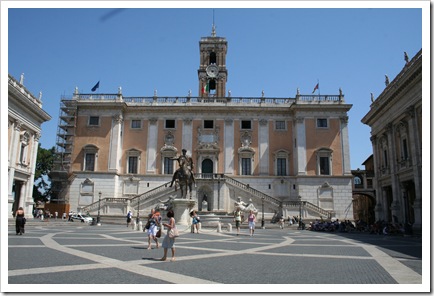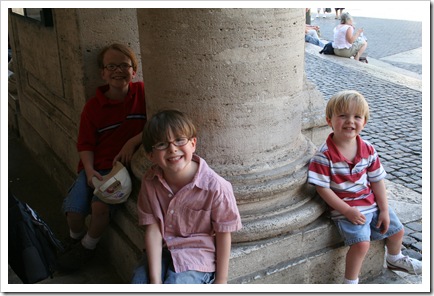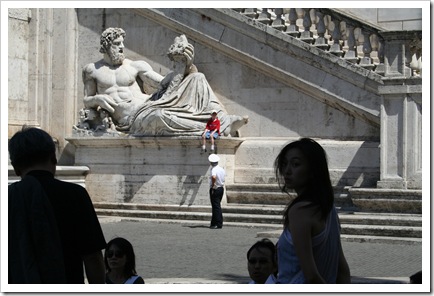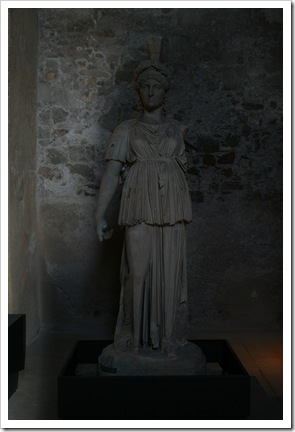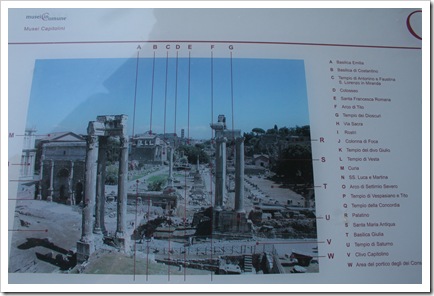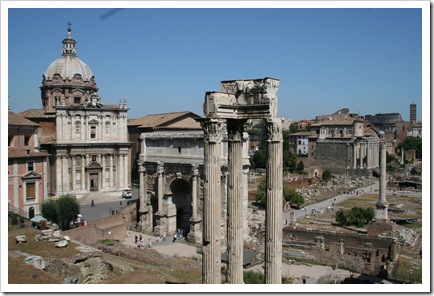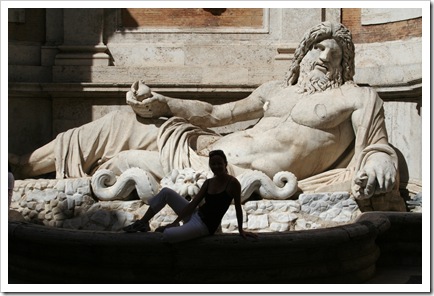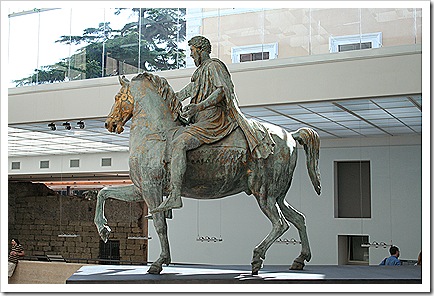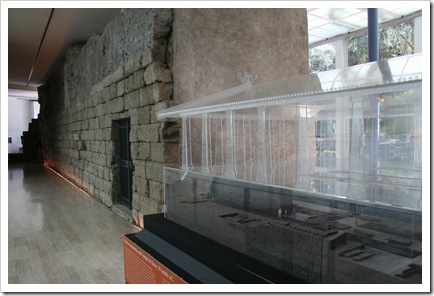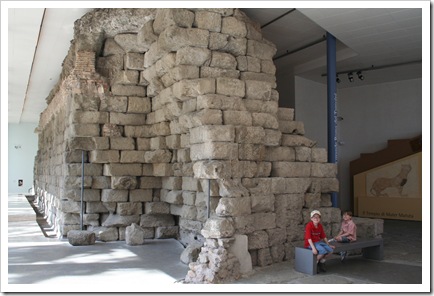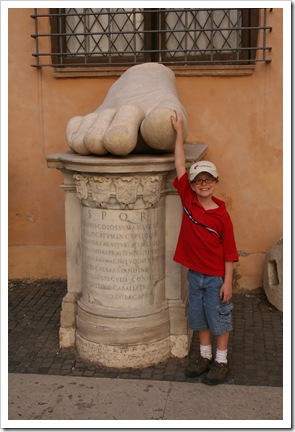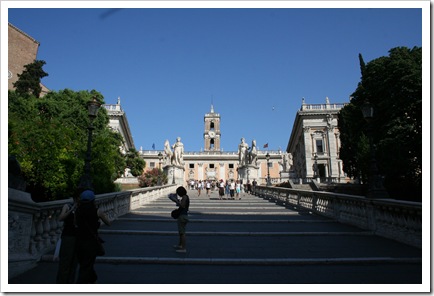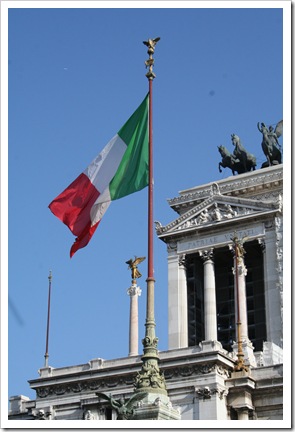Here we are…Day 3 of our Italian adventure! We arrived back safely from Pompeii last night and got up ready for another day of Roman discovery. What shall we see today?….
 San Giovanni in Laterano ~ (Basilica of St. John Lateran)
San Giovanni in Laterano ~ (Basilica of St. John Lateran)
This is the cathedral where the Pope officiates as Bishop of Rome, and it is the oldest of the four major (or papal) basilicas in the city of Rome. To this class belong: ST. John Lateran, St. Peter’s Basilica, Basilica of Saint Paul Outside the Walls, and St. Mary Major (or the Liberian Basilica).
Its History ~ The land where the cathedral church of Rome sits was once occupied by the estate of the Laterani Family. Constantine I obtained the estate in the 4th century when he wed a member of this wealthy patrician family. Later Constantine donated the domain for the building of a church. Early structures on the site were damaged by earthquakes, fire, and war. The church we see today dates back to 1646 when Pope Innocent X commissioned the architect Francesco Borromini to restore the basilica which was about to collapse. The current southern façade was added later; it was designed in the 18th century by Alessandro Galilei.
The adjacent Lateran Palace was the official residence of the Pope until it moved to Avignon in 1309. When the popedom moved back to Rome, it settled in the Vatican instead of the Lateran Palace. The church however remained Rome's principal cathedral.
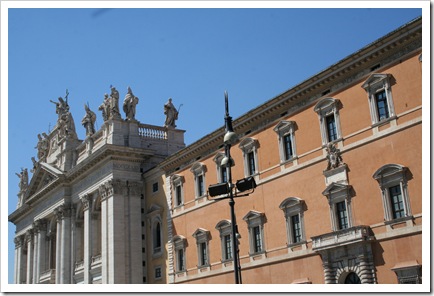 Look at the detail of those statues!! They are statues of Jesus and his apostles.
Look at the detail of those statues!! They are statues of Jesus and his apostles.
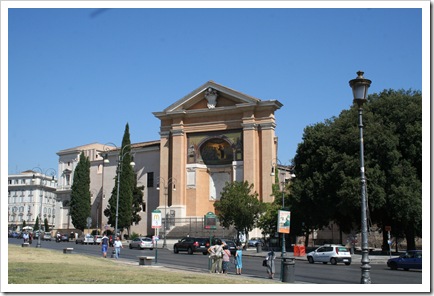 The apse of the papal dining hall, called the Triclinium Leoninum, which has been preserved on the outside of the remains of the old Lateran Palace. It has a beautiful mosaic from 800AD.
The apse of the papal dining hall, called the Triclinium Leoninum, which has been preserved on the outside of the remains of the old Lateran Palace. It has a beautiful mosaic from 800AD.
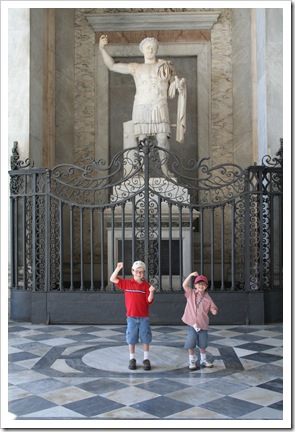 Even at a sacred basilica…the boys always come up with “something” to make us laugh! Gotta love those little men!
Even at a sacred basilica…the boys always come up with “something” to make us laugh! Gotta love those little men!
The interior of this basilica was simply breathtaking!! I took several photos…even though it is not the same as in person, I think you will be able to get an idea of its beauty. I still cannot get over the craftsmanship of ancient times! I will let you enjoy the following photos of the interior and then I’ll put a bit of “interior facts” at the end.
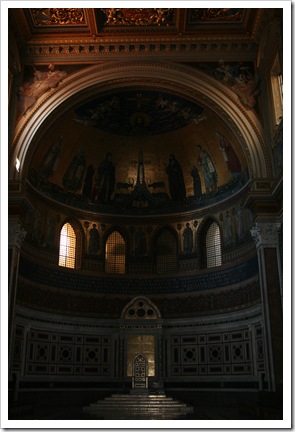 The Pope’s cathedra, or episcopal throne.
The Pope’s cathedra, or episcopal throne.
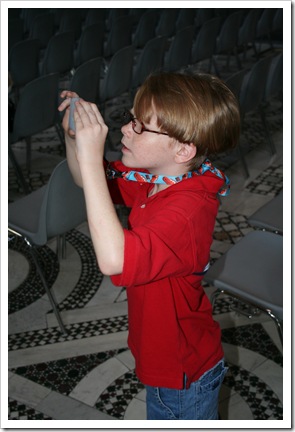 Even Cameron felt the need to “capture” the beauty of this place!
Even Cameron felt the need to “capture” the beauty of this place!
The “interior facts” (as promised ) ~ Despite the drastic renovations over the centuries, the Basilica of San Giovanni in Laterano still retains its original plan: a nave flanked by two aisles and ending in a semi-circular apse to the west. Unusually, the basilica is oriented to the west instead of the east: this is because it was built before the tradition of east-orientation had taken hold.
Some of the original decoration survives as well, although not in its original position. Parts of the 4th-century nave colonnade can now be seen supporting the triumphal arch (two red granite columns), flanking the Altar of the Holy Sacrament (four bronze columns), and flanking the statues of the apostles in the nave (24 green-speckled marble columns).
The Cosmatesque pavement in the nave is from the 14th century, making it a late example of this technique. It was paid by the Colonna family, and attained its present form in 1425 under Pope Martin V Colonna. The family's coat-of-arms can be seen in sevaral places on the floor.
The statues in the nave date from the time of Pope Clement XI (1701–1721) and depict Apostles and Evangelists. Closed doors painted on the wall behind the statues represent the gateways to Heavenly Jerusalem. Above the statues are 17th-century relief panels with Old Testament scenes on the left and related scenes from the New Testament on the right. Above are oval paintings of prophets, also from the 17th century.
The graceful baldacchino over the high altar, which looks out of place in its present surroundings, dates from 1369. At the top is a reliquary said to contain the heads of Saints Peter and Paul, but these may have been removed during the French occupation of Rome in the 18th century.
Beneath the baldacchino is the High Altar, which can only be used by the Pope. It contains a relic said to be part of St. Peter's communion table.
The Altar of the Holy Sacrament contains a cedar table that is said to be the one used by Christ at the Last Supper. The marble and bronze columns are said to have been taken from the Temple of Jupiter on the Capitoline Hill. The bronze columns in that temple had been recast from the bronze prows of Cleopatra's ships, taken in battle by Emperor Augustus.
More conspicuous than these relics are the enormous statues that are placed in the twelve niches Borromini created in the nave. The statues, which were added later, represent the twelve apostles. They were designed by a variety of prominent Rococo sculptors, including Francesco Moratti, Angelo de’ Rossi, and Pierre Le Gros the Younger.
There are also six papal tombs inside : They contain the remains of Alexander III, Sergius IV, Clement XIII, Martin V, Innocent III, and Leo XIII. After Leo XIII, popes were buried in St. Peter’s.
Whew!
A famous papal sanctuary located adjacent to the Basilica of St. John Lateran in Rome, the “Holy Staircase” is believed to be the actual steps that Jesus climbed the day He was sentenced to death. According to the Christian tradition, these are steps that led up to the praetorium (name for the commander's tent or house in a Roman fortification) of Pontius Pilate in Jerusalem, which Jesus Christ stood on during his Passion on his way to trial. The stairs were, reputedly, brought to Rome by St. Helena, mother of the Emperor Constantine in 334 A.D. For centuries, the Scala Santa has attracted Christian pilgrims who wished to honor the Passion of Jesus. Though not completely documented, this has been believed for over 1,200 years, since it was first mentioned in papal documents in 844. The 28 white marble stairs are known as the Scala Pilati (Pilate's stairway) or the Scala Sancti (holy stairway).
It has been proven that the staircase was first located in the Patriarchum, the complex of palaces that was the ancient seat of popes. In 1589, Pope Sixtus V had it located to it's present location in front of the ancient palatine chapel (the Sancta Sactorum). Pope Pius IX (1846-1878) restored the staircase, and promoted it's veneration as one of Christianity's great relics. The pope climbed the 28 steps on his knees many times, an act of veneration done that was done traditionally then, and continues to this day. A prayer related to the passion of Jesus Christ is recited upon each of the 28 steps.
In its new site the Scala Sancta is flanked by four other stairs, two on each side, for common use, since the Holy Stairs may only be ascended on the knees, a devotion much in favour with pilgrims and the Roman faithful, especially on Fridays and in Lent. Only a few popes are recorded to have performed this pious exercise; Pius IX, who in 1853 entrusted the Passionist Fathers with the care of the sanctuary, ascended the Holy Stairs on 19 Sept., 1870, the eve of the entrance of the Piedmontese into Rome.Pius VII on 2 Sept., 1817 granted those who ascend the stairs in the prescribed manner an indulgence of nine years for every step. Finally Pius X, on 26 Feb., 1908, granted a plenary indulgence to be gained as often as the stairs are devoutly ascended after confession and communion. Imitations of the Scala Sancta have been erected in various places, as in Lourdes and in some convents of nuns, and indulgences are attached to them by special concessions.
At the foot of the Holy Staircase, before beginning your ascent
on your knees, recite:
"My Jesus, by the merits of your passion, I pray that you inspire
in me feelings of faith, of hope, and of charity, and that you grant
me pardon for my sins, while I, having decided to change my
life, proceed to climb the Staircase, which I venerate as a memento
of your sacrifice and as a spur to trusting in your mercy in this
life and to getting myself ready for eternal salvation in the next.
Amen."
 World travel journalists in the making…:)
World travel journalists in the making…:)
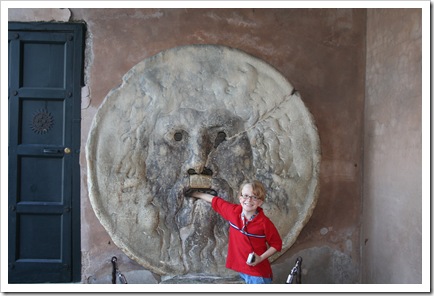 Cameron “taking his chances” with the Mouth of Truth!
Cameron “taking his chances” with the Mouth of Truth!
You ask, what is that? Here goes… La Bocca della Verita (the Mouth of Truth, in English) is a Roman stautue located in the portico of the Paleochristian church of Santa Maria in Cosmedin, at the foot of the Aventine hills. This statue has attracted the attention and curiosity of tourists from all over the world. It is an ancient stone mask from the Classical period which represents a river god with an open mouth, wide-eyes and a flowing mane of hair. It is thought to be part of a 1st century ancient Roman fountain, or perhaps a manhole cover, portraying one of several possible pagan gods, probably Oceanus. Most Romans believed that the “Bocca” represents the ancient god of the River Tiber.
The Legend ~ The reason for its unshakeable fame is a rather macabre legend associated with the mask since ancient times ~ If a liar puts their hand inside its mouth,they will lose it. The legend probably originates from Roman times. It is said that the rich wife of a Roman noble was accused of adultery. The woman denied the accusations, but her husband wanted to put her to the test by making her place her hand inside the stone mouth. Knowing perfectly well that she was lying, the woman used a very clever strategy. In front of a group of curious bystanders who had gathered around the Mouth of Truth, the man who was actually her lover embraced her and kissed her. She pretended that she didn't know him and accused him of being a madman and the crowd chased him away. When she put her hand into the mouth, the woman declared that she had never kissed any other man apart from her husband and the poor madman who had just kissed her. In this way she was certain that she hadn't lied and her hand was saved. The betrayed husband saved her honour, but the Mouth of Truth lost its credibility and it is said that since that day it no longer carried out its function as a right and unappeasable judge.
Its Fame ~ The mask is so famous that even Hollywood honoured it in a film about the city called “Roman Holiday”. In one of the most memorable scenes, Gregory Peck, in front of a terrified Audrey Hepburn, daringly challenges the mask by putting his hand inside its mouth. Even today, this ancient mask is the cause of queues of tourists who line up outside the beautiful Paleochristian church of Santa Maria in Cosmedin. The thrill of the risk is evidently too strong and you honestly can't resist putting your hand inside this harmless, but unsettling stone face and hope for the best! We were some of those tourists who just “had to” give it a go!
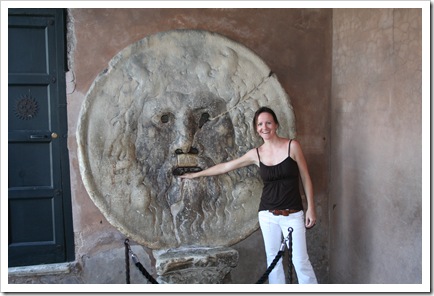 Needless to say, we all remained unscathed by the Mouth of Truth! So is there any truth to the tales…it leaves you wondering! :)
Needless to say, we all remained unscathed by the Mouth of Truth! So is there any truth to the tales…it leaves you wondering! :)
Built more than 1800 years ago, the magnificent Pantheon building still stands as a reminder of the great Roman empire. It is the Roman monument with the greatest number of records: the best preserved, with the biggest brick dome in the history of architecture and is considered the forerunner of all modern places of worship. It is the most copied and imitated of all ancient works.
The original Pantheon was built in 27 to 25 B.C. during the third consulship of Marcus Vipsanius Agrippa, but was destroyed by fire in 80 A.D. Date stamps on the bricks indicate that the current building dates from about 125, and was built during the reign of the Emperor Hadrian. Although the building was totally reconstructed, an inscription that was on the original Pantheon was added to the facade of the new Pantheon. The inscription reads M·AGRIPPA·L·F·COS·TERTIUM·FECIT, "Marcus Agrippa, son of Lucius, consul for the third time, built this". The building was later repaired by Septimius Severus and Caracalla. In 609 the Byzantine emperor Phocas gave the building to Pope Boniface IV, who re-consecrated it as a Christian church, the "Santa Maria ad Martyres" or the "Church of Mary and all the Martyr Saints". A title that it retains to this day. (You will recognize some of these names from monuments in the Roman Forum, our Day 1 of Rome.)
Michelangelo felt it was the work of angels, not men.
Location ~ The Pantheon borders the Piazza della Rotonda, a rectangular square with a central fountain and obelisk. The often crowded square is situated in the historic center of Rome, not far from the Piazza Navone, one of Rome's most beautiful squares.
Where it stands was not chosen by chance, but is a legendary place in the city's history. According to Roman legend, it is the place where the founder of Rome, Romulus, at his death was seized by an eagle and taken off into the skies with the Gods.
The huge, 60 tons weighing columns used for the portico were quarried in Egypt. They were transported all the way to Rome using barges and vessels. The columns support a pediment with an inscription attributing the Pantheon to Marcus Agrippa even though it was built by Hadrian.
With its thick brick walls and large marble columns, the Pantheon makes an immediate impression on visitors. But for its time, the most remarkable part of the building is the more than 43 meter high dome. It was the largest dome in the world until 1436 when the Florence Cathedral was constructed. At the top of the dome is a large opening, the oculus, which was the only source of light. The front portico has three rows of 8 columns, each one with a diameter of 1.5m. A huge bronze door gives access to the cylindrical building. Its diameter equals the interior height of 43,3m.
The most important problem the Romans faced during the construction of the Pantheon was the massive weight of the large dome. In order to support it without proper reinforcement as it is common today, the thickness of the walls gradually decreased as the height increased. The Romans also used a different type of concrete for the dome as for the walls. At the base very thick (6m, 20ft) walls were constructed. At the top of the dome, a lighter type of concrete was used and near the oculus it is only 7.5 ft or 2.3 m thick. The use of coffers in the ceiling and the opening at the top also helped reduce the weight of the dome.
Interior ~ Originally a temple for all pagan gods, the temple was converted into a church in 609. The Pantheon now contains the tombs of the famous artist Raphael and of several Italian Kings. Its ecclesiastic interior design contrast with the temple's structural design, but the marble floor - which features a design consisting of a series of geometric patterns - is still the ancient Roman original.

This Roman history is just amazing! We are so loving this place! After taking in all of the Pantheon’s beauty, we went right across the Piazza della Rotunda to get a bite to eat…guess what was there?! McDonald’s!! Not that I went all the way to Italy to eat Mickey D’s, but there was just no persuading the boys!:) So we went, enjoyed the shade of their outdoor seating, and had some ice cream! Yum!
 Landen making sure he had his fair share. He was funny…he didn’t like it dripping on his hands, so he was making us “serve” him. It was so hot, even in the shade, that it was melting faster than he could eat it!
Landen making sure he had his fair share. He was funny…he didn’t like it dripping on his hands, so he was making us “serve” him. It was so hot, even in the shade, that it was melting faster than he could eat it!
 Proof of Landen’s ice cream enjoyment…despite the melting!
Proof of Landen’s ice cream enjoyment…despite the melting!


